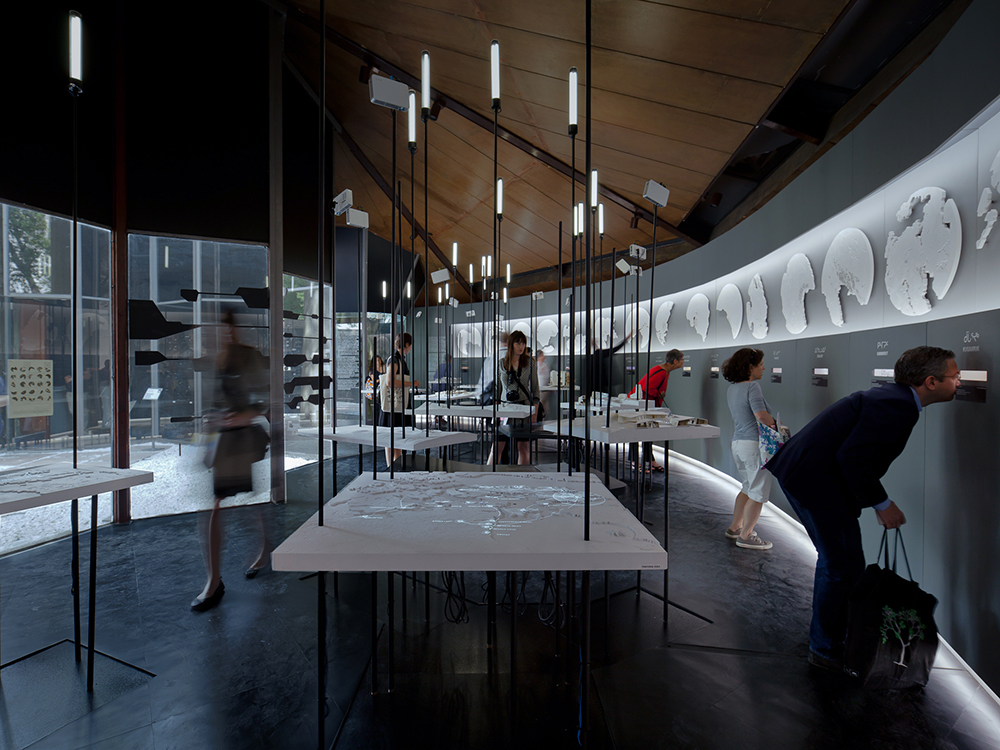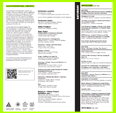University of Waterloo
View of Arctic Adaptations exhibition, Arctic Adaptations, 2014.
Image courtesy of Latreille Delage Photography.
Canada at the 14th International Architecture Exhibition – la Biennale di Venezia
Arctic Adaptations: Nunavut at 15, Canada’s national exhibition at the 14th International Architecture Exhibition— la Biennale di Venezia, recently received a Special Mention Golden Lion Award for Canada and was ranked as one of the top 10 exhibitions by AZURE. The exhibition was organized and curated by Lateral Office, whose partners are Lola Sheppard, Associate Professor at the University of Waterloo and Mason White, Associate professor at the University of Toronto. Matthew Spremulli, adjunct professor the University of Waterloo, is a co-curator.
Arctic Adaptations: Nunavut at 15 surveys a recent architectural past, a current urbanizing present, and a projective near future of adaptive architecture in Nunavut, Canada’s newest, largest, and most northerly territory, which celebrates its 15th anniversary in 2014. Today, there are almost 33,000 people living in 25 communities across two million square kilometres, making Nunavut one of the least densely populated regions in the world. These communities, located above the tree line and with no roads connecting them, range in population from 120 in the smallest hamlet to 7,000 in Nunavut’s capital city of Iqaluit. The climate, geography, and people of Nunavut, as well as the wider Canadian Arctic, challenge the viability of a universalizing modernity.
Modern architecture and urbanism encroached on this remote and vast region of Canada in the name of sovereignty, aboriginal affairs management, or trade, among others. However, the indigenous Inuit people have inhabited the Canadian Arctic for millennia as a traditionally semi-nomadic people. Inuit relations with Canada have been fraught with acts of neglect, resistance, and negotiation. People have been re-located; trading posts, military infrastructure, and research stations have been built; and small settlements are now emerging as Arctic cities. Some have described this rapid confrontation with modernity as a transition “from igloos to internet” compressed into forty years. This abruptness has revealed powerful traits among its people—adaptation and resilience—qualities which modern architecture has often lacked.
Arctic Adaptations responds to the shared theme of the 14th International Architecture Exhibition: Absorbing Modernity: 1914-2014. The exhibition documents modernism’s legacy in this remarkable but relatively unknown region of Canada, describes the contemporary realities of life in its communities, and examines a projected role for architecture moving forward. It argues that modern Inuit cultures continue to evolve and merge the traditional and the contemporary in unique and innovative ways, and questions whether architecture, which has largely failed this region—both technically and socially—can be equally innovative and adaptive.
The exhibition looks at the past 100 years through a series of carvings by Inuit artists of important buildings. It presents its current context through a series of bas relief models describing every community in Nunavut, paired with photographs taken by residents within each community. It projects forward 15 years, through a series of speculative architecture projects
Developed by five design teams. Each team is made up of a Canadian school of architecture, a Canadian architecture office with extensive northern experience, and a Nunavut-based organization. Each team’s proposal examines one theme – housing, health, education, arts, or recreation – and is rooted in Nunavut’s distinct land, climate and culture. A series of 15 ‘living models’ brought to life by time-based animations, hover in the exhibition space, describing proposals at three scales: the territorial, the community and the architectural scale.
Arctic Adaptations: Nunavut at 15 will be at the Canada Pavilion at the 14th International Architecture Exhibition – la Biennale di Venezia from June 7 – November 23, 2014.
A catalogue, Arctic Adaptations: Nunavut at 15, as well as a broadly accessible publication, entitled Many Norths: Spatial Practices in a Shifting Territory, will accompany Arctic Adaptations. After the exhibition returns from Venice it will tour Canada in 2015-17.
Links to other media:
Azure Magazine:
http://www.azuremagazine.com/article/dispatch-venice-biennale/
Canadian Architect

 Study Architecture
Study Architecture  ProPEL
ProPEL 







